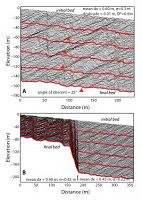Digital glacier bed
Digital model of glacier bed
Computes evolution of a glacial bed at the 1-meter scale , mimicking both abrasion and block removal by quarrying
Model Category: Numerical
Image: This figure illustrates a model of the evolution of a reach of glacier bed. Initial bed is characterized by random noise around a mean slope of 0.1. Of the 2000 time steps, the bed profile is drawn at 100 intervals (black profiles). Abrasion of ice-bedrock contact sites = 0.01 m/time step. Five profiles are highlighted in red. A) Block sizes are chosen from a uniform normal distribution with mean 0.6 m; all blocks in any given column are the same size. B) Blocks in the two halves of the calculation space are chosen from two distributions, that on the left two times coarser than on the right. Columns of large blocks localize sites of quarrying. Black striping reflects migration of bedforms (angle of descent is 25°) at roughly the angle of the stoss slope; representative upvalley-migrating bedforms depicted by the red arrows. Major step in the bed in (B) corresponds to transition between fracture domains.
-
Boulder, INVESTIGATOR
At small scales, glaciated valleys are lumpy. They sport rocky knobs with smooth abraded up-valley surfaces and sharp, quarried down-valley edges. Using numerical models, I address the evolution of glacial landforms in order to explore the dependence of bed topography on both glacier and rock properties. Sliding of a glacier against its rocky bed, a prerequisite for both erosion processes of abrasion and quarrying, is governed by water pressures at the glacier bed. On daily timescales, variations in water pressure associated with snow and ice melt cycles result in expansion and collapse of water-filled cavities at the bed that in turn repetitively stress corners in the bed. Numerical models of glacial bed evolution at longer timescales incorporate both abrasion and quarrying of fracture-bound blocks. Using a rule in which the probability of block quarrying during a stress event depends inversely upon both block size and the depth of the niche in which it sits, up-glacier migrating rocky bumps inevitably emerge, reflecting efficient quarrying of blocks from down-valley facing steps in the bed. The relative importance of abrasion and quarrying is controlled by fracture spacing, and major steps in the valley floor are attributable to transitions in fracture spacing.
From Figure 5 in Anderson, R.S., 2014, Evolution of lumpy glacial landscapes
Model of the evolution of a reach of glacier bed. The glacier overrides this bed moving from left to right. Initial bed is characterized by random noise around a mean slope of 0.1. Black dots record sites of quarrying. Red sites indicate abrasion. Note the upvalley migration of small steps in the bed, and the emergence of upvalley migrating rocky bedforms with abrading stoss (upvalley-facing) slopes and quarried lee slopes.
Reference: Anderson, R. S. (2014): Evolution of lumpy glacial landscapes. Geology 42(8): 679–682
Publications
2014
Evolution of lumpy glacial landscapes. Anderson, R. S. (2014): Geology 42(8): 679–682
Explore Further


